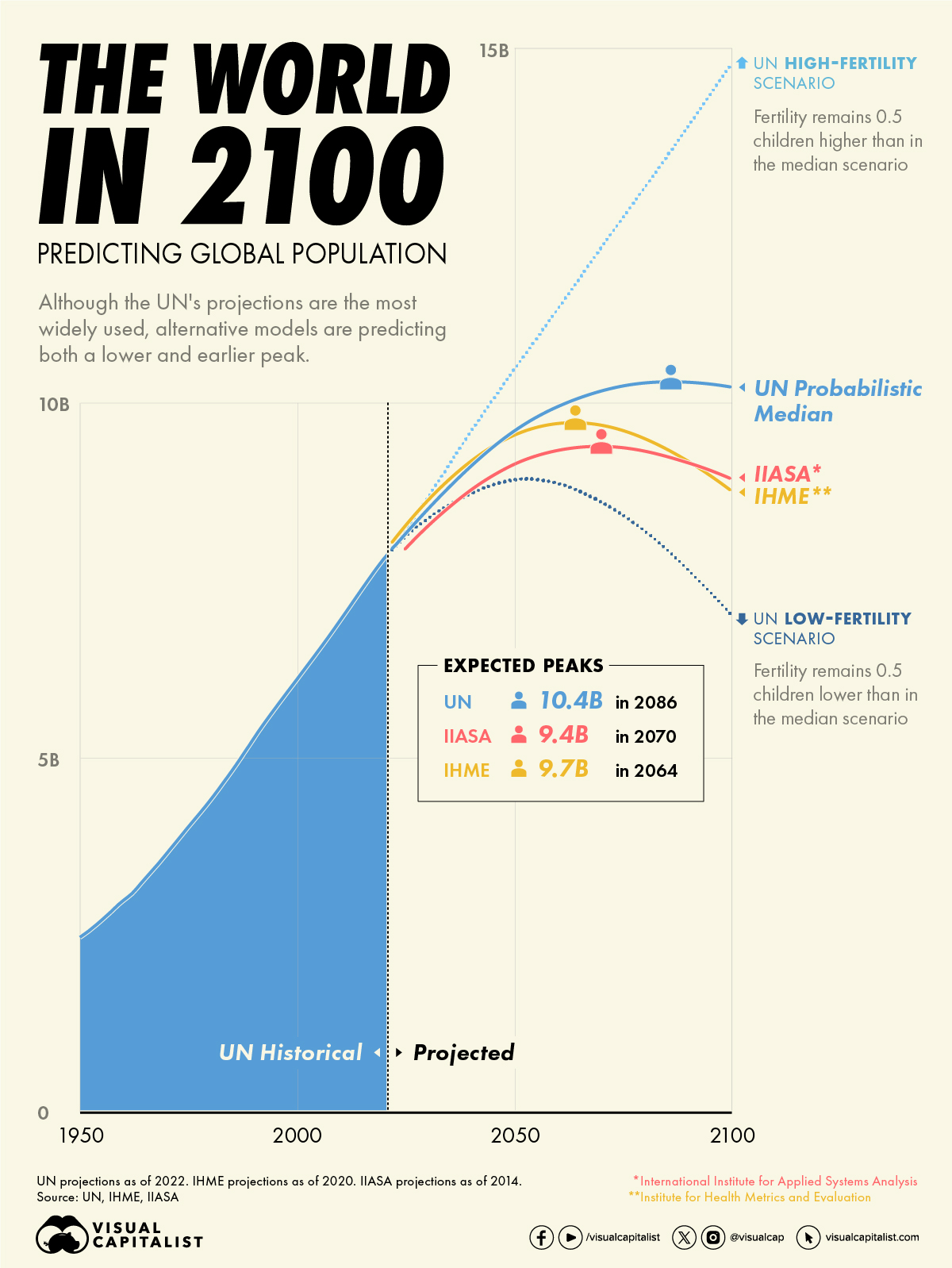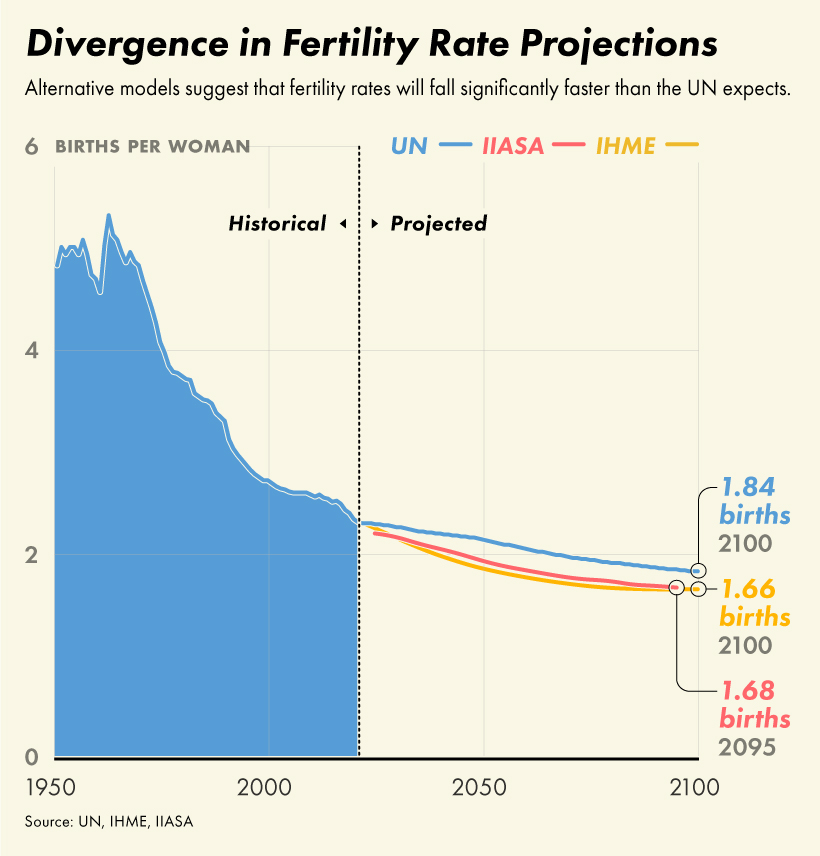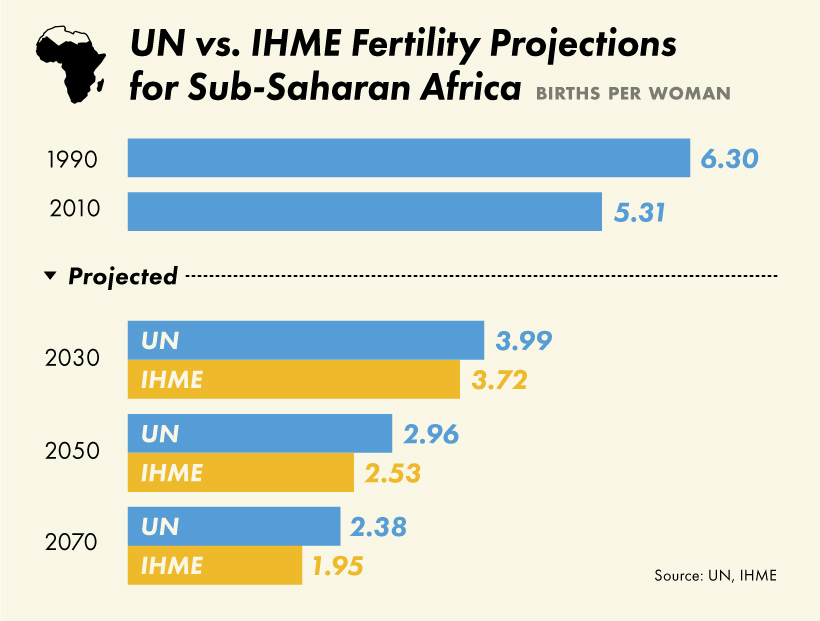
Comparing Global Population Projections to 2100
When will the world reach its peak population?
According to data from the United Nations’ 2022 Revision of its World Population Prospects, we could see a peak of over 10.4 billion people sometime in the late 2080s.
While the UN’s projections are the most widely used, this doesn’t necessarily mean they’re the most accurate. Several alternative models have predicted an earlier and lower peak, suggesting that the world’s population could decline sooner than expected.
In the UN’s latest revisions, it lowered its own estimates for global population in 2100, from 10.9 billion (as of 2019) to 10.4 billion (as of 2022).
In this graphic, we’ve visualized population projections to 2100 from three organizations: the UN, the Institute for Health Metrics and Evaluation (IHME), and the International Institute for Applied Systems Analysis (IIASA).
Data and Highlights
The population projection data we used to create this graphic is listed in the table below. Note that UN projections are as of 2022, IHME are as of 2020, and IIASA are as of 2014.
| Year | UN | IHME | IIASA |
|---|---|---|---|
| 2050 | 9,687,440,000 | 9,551,506,077 | 9,140,396,000 |
| 2060 | 10,053,522,000 | 9,719,318,272 | 9,340,845,000 |
| 2070 | 10,288,412,000 | 9,700,610,324 | 9,397,164,000 |
| 2080 | 10,411,747,000 | 9,515,888,869 | 9,334,601,000 |
| 2090 | 10,425,269,000 | 9,200,632,391 | 9,173,133,000 |
| 2100 | 10,355,002,000 | 8,785,553,665 | 8,948,235,000 |
From this data we can see that the UN expects the world to hit peak population in 2086, as well as maintain above 10 billion people in 2100.
On the other hand, neither the IHME nor IIASA models expect global population to reach 10 billion, instead forecasting a peak of 9.7 billion in the 2060s (IHME) or 9.4 billion in 2070 (IIASA). Both models also predict population to fall back to the 8 billion range by 2100.
The differential at 2100 is substantial, with IHME’s forecast lower than the UN’s by 1.6 billion people, for example.
What Is the IHME and IIASA, and Why Do They Differ?
The Institute for Health Metrics and Evaluation (IHME) is a Seattle-based research institute founded in 2007 by the Bill & Melinda Gates Foundation. Its mission is to “deliver to the world timely, relevant, and scientifically valid evidence to improve health policy and practice.”
The International Institute for Applied Systems Analysis (IIASA), on the other hand, is an international research institute based in Austria, dating back to 1972. It was established to improve scientific cooperation between the Soviet Union and the U.S., and today has members in over 20 countries.
To understand why the IHME and IIASA models differ from the UN’s, let’s look at each organization’s projections for fertility rate, which is measured as the number of children per woman.

Based on this chart, the IHME and IIASA expect global fertility rates to fall at a quicker rate pre-2050, then stabilize as we approach 2100. This contrasts with the UN’s projections, which expect fertility to decrease at a slower, steadier rate all the way to 2100.
Generally speaking, a country’s birth rate declines as it becomes more developed. This is due to many factors like higher education rates for women (and thus more women in the workforce), greater access to contraceptives and family planning, as well as higher childbearing costs.
How Fast Will Fertility Rates Fall in Africa?
Sub-Saharan Africa has one of the highest fertility rates in the world, but this is quickly falling as the region experiences rapid economic growth.. For instance, GDP per capita in Sub-Saharan Africa has climbed from $632 in 2000, to $1,690 in 2022.
Because of this economic transformation, some researchers believe that Africa will undergo a fast demographic transition similar to East Asia, in which population growth falls off sharply. For instance, a UNICEF survey from 2021 found that fertility rates in Nigeria had fallen from 5.8 to 4.6 (a 17% decrease) in just five years time.
Consider this July 2023 article from the Wilson Center for more context on the evolution of Nigeria’s demographics.
Now going back to the question at hand, let’s see how the UN and IHME’s fertility rate projections for Sub-Saharan Africa differ.

These differences may seem small, but even a few decimal places can have a huge impact. For example, let’s revisit the UN’s population projection for the year 2100, which was 10.4 billion people.
Under the UN’s low fertility scenario (birth rates remain 0.5 lower), population in 2100 would be a significantly smaller 7.0 billion. Meanwhile, under the high fertility scenario (birth rates remain 0.5 higher), population would balloon to 14.7 billion.
As a result, how birth rates change in high fertility regions like Sub-Saharan Africa will have a significant influence on when the global population will reach its peak.
The post When Will the Global Population Reach Its Peak? appeared first on Visual Capitalist.